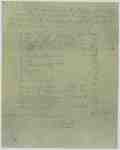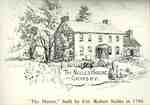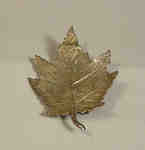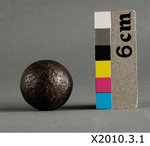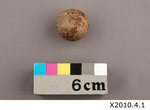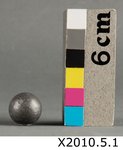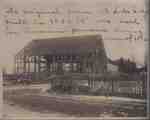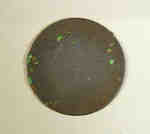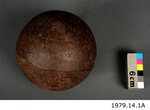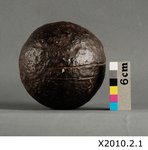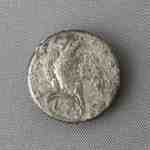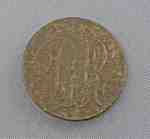Résultats
- An estimate of damage done on the Robert Nelles (1761-1842) property at Forty Mile Creek by the United States Army during their encampment on the premises. The list of damages included items such asAn estimate of damage done on the Robert Nelles (1761-1842) property at …
- A print of the Robert Nelles Manor in 1798. Nelles was a Lieutenant-colonel of the 4th Regiment of the Lincoln Militia by the end of the War. He was also known to have been a Justice of the Peace andA print of the Robert Nelles Manor in 1798. Nelles was a …
- This is a silver maple leaf pin from the Loyal Canadian Society. Every year, since its organization in 1847, this society held its Annual Dinner on the 13 of October; the anniversary of General BrockThis is a silver maple leaf pin from the Loyal Canadian Society. …
- A wooden shingle from the barn at Lake Lodge. It has four holes in the body and curves in the centre. There is writing on the end of one side that states: "Aug. 9, 1932, shingle from barn of Lake LodA wooden shingle from the barn at Lake Lodge. It has four …
- A commemorative ribbon celebrating 100 years of peace between Great Britain and the United States of America. The front has a metal piece with the years 1814 and 1914 and a "G" symbol on it with theA commemorative ribbon celebrating 100 years of peace between Great Britain and …
- Referred to "The Military Arms of Canada" by The Upper Canada Historical Arms Society and "The British Military Longarms 1715-1815' by D.W. Bailey.Referred to "The Military Arms of Canada" by The Upper Canada Historical …
- This type of ammunition, known as a grapeshot, was used in artillery during the War of 1812. A round black ball of iron with a pitted surface, this grapeshot has a circumference of 4 1/8 inches. GrapThis type of ammunition, known as a grapeshot, was used in artillery …
- This is an example of ammunition used in artillery during the War of 1812. Commonly termed a grapeshot, this round grayish ball of lead has a circumference of 3 3/4 inches. The surface is not smoothThis is an example of ammunition used in artillery during the War …
- This type ammunition was used in a musket during the War of 1812. A small round silver ball of lead, this musket ball is 2 1/8 inches in circumference. The surface is shiny and smooth with a visibleThis type ammunition was used in a musket during the War of …
- A medical discharge from military duty for Isaac Smith. Confirmed by Dr. Robert Kerr and John [J]. Taylor, attest by Lieut. Jonathon Pettit and signed by [G. Fairbel]. Smith was discharged from militA medical discharge from military duty for Isaac Smith. Confirmed by Dr. …
- A receipt of pay, dated June 2, 1814, from Captain Henry Nelles (1789-1841) to other companies within the 4th Regiment of the Lincoln Militia. This Regiment was known to have been involved in the BatA receipt of pay, dated June 2, 1814, from Captain Henry Nelles …
- A memorandum of Militia Pay due for July 1815. Men's names and amounts due are handwritten on paper. It can be assumed that these men belong to the 4th Regiment of the Lincoln Militia as Henry NellesA memorandum of Militia Pay due for July 1815. Men's names and …
- A black and white photograph of the original barn at Lake Lodge, built in 1801, as it was being demolished. Written in ink on the photograph is : "The original barn at Lake Lodge built in 1801. It waA black and white photograph of the original barn at Lake Lodge, …
- A letter from Dr. Robert Kerr to Dr. Cyrus Sumner(1772-1834) appointing him Assistant Surgeon at the hospital in Niagara during the War of 1812. His pay is quoted as one dollar and a half per day. ItA letter from Dr. Robert Kerr to Dr. Cyrus Sumner(1772-1834) appointing him …
- This coin is from Upper Canada and is dated 1816. On one side the date is in the centre surrounded by the words: "SUCCESS TO COMMERCE & PEACE". On the other side there is an urn in the centre, toppedThis coin is from Upper Canada and is dated 1816. On one …
- The origin of the sword is unknown and there are no distinct markings on it. It is believed however, that the sword would have been carried by the Light Cavalry (Light Dragoons and the Hussars). TheThe origin of the sword is unknown and there are no distinct …
- A cannonball of this type would have been used during the War of 1812. This brown, iron cannonball is 16 inches in circumference and approximately 5 inches in diameter. The surface is of the cannonbaA cannonball of this type would have been used during the War …
- This type of cannon ball was used during the War of 1812. This round, black ball of iron has a pitted surface and is 14 1/2 inches in circumference and 5 inches in diameter. There is a 4 mm wide andThis type of cannon ball was used during the War of 1812. …
- United States of America Infantry button made of white metal with an eagle on a branch and “US” in an oval below. The shank is bent on the reverse. The button diameter is 1 cm.United States of America Infantry button made of white metal with an …
- Button has letters R.R intertwined with no shank on the reverse. Diameter is 1.5 cm.Button has letters R.R intertwined with no shank on the reverse. Diameter …





